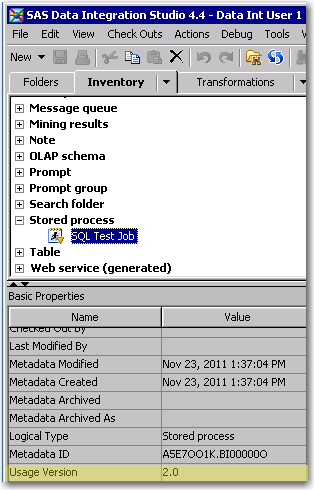Working with Stored Processes
Overview
Deploy a Job as a Version 1.0 or Version 2.0 Stored Process
You can deploy an existing
job as a version 1.0 or version 2.0 stored process. For information,
see the stored process topics in Deploying Jobs as Stored Processes.
Create a Version 2.0 Stored Process
To create a new version
2.0 stored process that is not based on a SAS Data Integration Studio
job, right-click a folder in the Folders tree and select Stored
Process from the New menu. You
can also select Stored Process in the New item
on the toolbar. Either method displays the New Stored
Process wizard.
Convert a Stored Process from One Version to Another
You can convert a stored
process from one version to another. For example, you might deploy
a job as a version 1.0 stored process, but later you might want to
take advantage of the version 2.0 features. In that case, you can
deploy the job as a version 1.0 stored process. Then, you can upgrade
that stored process to version 2.0 and access the new features.
To convert a version
1.0 stored process to version 2.0, right-click the stored process
and select Upgrade. You can verify that the
version number in the Usage Version field
in the Basic Properties pane has been changed to 2.0. You can open
the Properties window of the upgraded stored
process and enable the 2.0 features on the Execution tab.
You might also want
to convert a version 2.0 stored process to a version 1.0 stored process
in order to run it on an older server (a server with a version prior
to SAS 9.3). To convert a version 2.0 stored process, select the stored
process. Open the Properties window to verify
that no features that are unique to version 2.0 are being used. Then,
right-click the stored process and select Make Compatible.
If the stored process runs on a SAS Workspace server, make sure that
the *ProcessBody; comment is included in the source code. You can
verify that the version number in the Usage Version field
in the Basic Properties pane has been changed to 1.0.
Copyright © SAS Institute Inc. All rights reserved.
